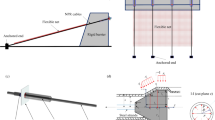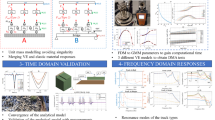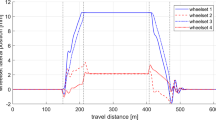Abstract
Since brake wear is an important contributor to the concentration of airborne particles in urban atmospheres, it is important to increase our understanding of the origin of these particles. The contact situation between the pad and disc is complicated. Metal fibres in the pad (or other hard materials) form stable contact plateaus, which carry the main part of the load. A flow of wear particles in the boundary layer between the pad and disc partially stack up against these plateaus (and increase their area), and some will escape from the contact and become airborne. The purpose of this article is to investigate the possibility to numerically simulate the contact situation in the boundary layer between the pad and disc and the amount of wear that leaves the contact using a cellular automaton approach. To do so, the contact pressure, pad temperature and wear are determined in that order. Based on these results, the creation, growth and destruction of contact plateaus are simulated using a cellular automaton model. Finally, the amount of wear that leaves the contact is determined. The simulated behaviour of the contact situation correlates qualitatively with experimental observations found in the literature.
















Similar content being viewed by others
References
Pope, C.A., Burnett, R.T., Thun, M.J., Calle, E.E., Krewski, D., Ito, K., Thurston, G.D.: Lung cancer, cardiopulmonary mortality, and long-term exposure to fine particulate air pollution. JAMA 287, 1132–1141 (2002)
Hjortenkrans, D., Bergbäck, B., Häggerud, A.: Metal emissions from brake linings and tires: case studies of Stockholm, Sweden 1995/1998 and 2005. Environ. Sci. Technol. 41, 5224–5230 (2007)
Gasser, M., Riediker, M., Mueller, L., Perrenoud, A., Blank, F., Gehr, P., Rothen-Rutishauser, B.: Toxic effects of brake wear particles on epithelial lung cells in vitro. Part. Fibre Toxicol. 6(30), 1–13 (2009)
Wahlström, J., Söderberg, A., Olander, L., Jansson, A., Olofsson, U.: A pin-on-disc simulation of airborne wear particles from disc brakes. Wear 268, 763–769 (2010)
Wahlström, J., Söderberg, A., Olander, L., Olofsson, U.: A disc brake test stand for measurements of airborne wear particles. Lubr. Sci. 21, 241–252 (2009)
Wahlström, J., Söderberg, A., Olander, L., Jansson, A., Olofsson, U.: Airborne wear particles from passenger car disc brakes: a comparison of measurements from field tests, a disc brake assembly test stand, and a pin-on-disc machine. Proc. IMechE Part J: J. Eng. Tribol. 224, 179–188 (2010)
Eriksson, M., Bergman, F., Jacobson, S.: On the nature of tribological contact in automotive brakes. Wear 252, 26–36 (2002)
Österle, W., Griepentorg, M., Gross, Th., Urban, I.: Chemical and microstructural changes induced by friction and wear of brakes. Wear 251, 1469–1476 (2001)
Ostermeyer, G.P.: Friction and wear of brake systems. Forsch. Ingenieurwes 66, 267–272 (2001)
Eriksson, M.: Friction and contact phenomena of disc brakes related to squeal. 2000. Comprehensive Summaries of Uppsala Dissertations, Faculty of Science and Technology, Uppsala (2000)
Österle, W., Urban, I.: Friction layers and friction films on PMC brake pads. Wear 257, 215–226 (2004)
Österle, W., Urban, I.: Third body formation on brake pads and rotors. Tribol. Int. 39, 401–408 (2006)
Österle, W., Kloss, H., Urban, I., Dmitriev, A.I.: Towards a better understanding of brake friction materials. Wear 263, 1189–1201 (2007)
Söderberg, A., Andersson, S.: Simulation of wear and contact pressure distribution at the pad-to-rotor interface in a disc brake using general purpose finite element analysis software. Wear 267, 2243–2251 (2010)
Ostermeyer, G.P., Müller, M.: New insights into the tribology of brake systems. Proc. Imeche Part D: J Automobile Eng. 222, 1167–1200 (2007)
Müller, M., Ostermeyer, G.P.: A cellular automaton model to describe the three dimensional friction and wear mechanism of brake systems. Wear 263, 1175–1188 (2007)
Müller, M., Ostermeyer, G.P.: Cellular automata method for macroscopic surface and friction dynamics in brake systems. Tribol. Int. 40, 942–952 (2007)
Söderberg, A., Björklund, S.: Validation of a simplified numerical contact model. Tribol. Int. 41, 926–933 (2008)
Archard, J.F.: Contact and rubbing of flat surfaces. J. Appl. Phys. 24, 981–988 (1953)
Holm, R.: Electric Contacts. Almqvist & Wiksells, Uppsala (1946)
Hong, U.S., Jung, S.L., Cho, K.H., Cho, M.H., Kim, S.J., Jang, H.: Wear mechanism of multiphase friction materials with different phenolic resin matrices. Wear 266, 739–744 (2009)
Olofsson, U., Olander, L., Jansson, A.: Towards a model for the number of airborne particles generated from a sliding contact. Wear 267(12), 2252–2256 (2009)
Eriksson, M., Lord, J., Jacobson, S.: Wear and contact conditions of brake pads: dynamical in situ studies of pad on glass. Wear 249(3–4), 272–278 (2001)
Author information
Authors and Affiliations
Corresponding author
Rights and permissions
About this article
Cite this article
Wahlström, J., Söderberg, A. & Olofsson, U. A Cellular Automaton Approach to Numerically Simulate the Contact Situation in Disc Brakes. Tribol Lett 42, 253–262 (2011). https://doi.org/10.1007/s11249-011-9772-z
Received:
Accepted:
Published:
Issue Date:
DOI: https://doi.org/10.1007/s11249-011-9772-z




